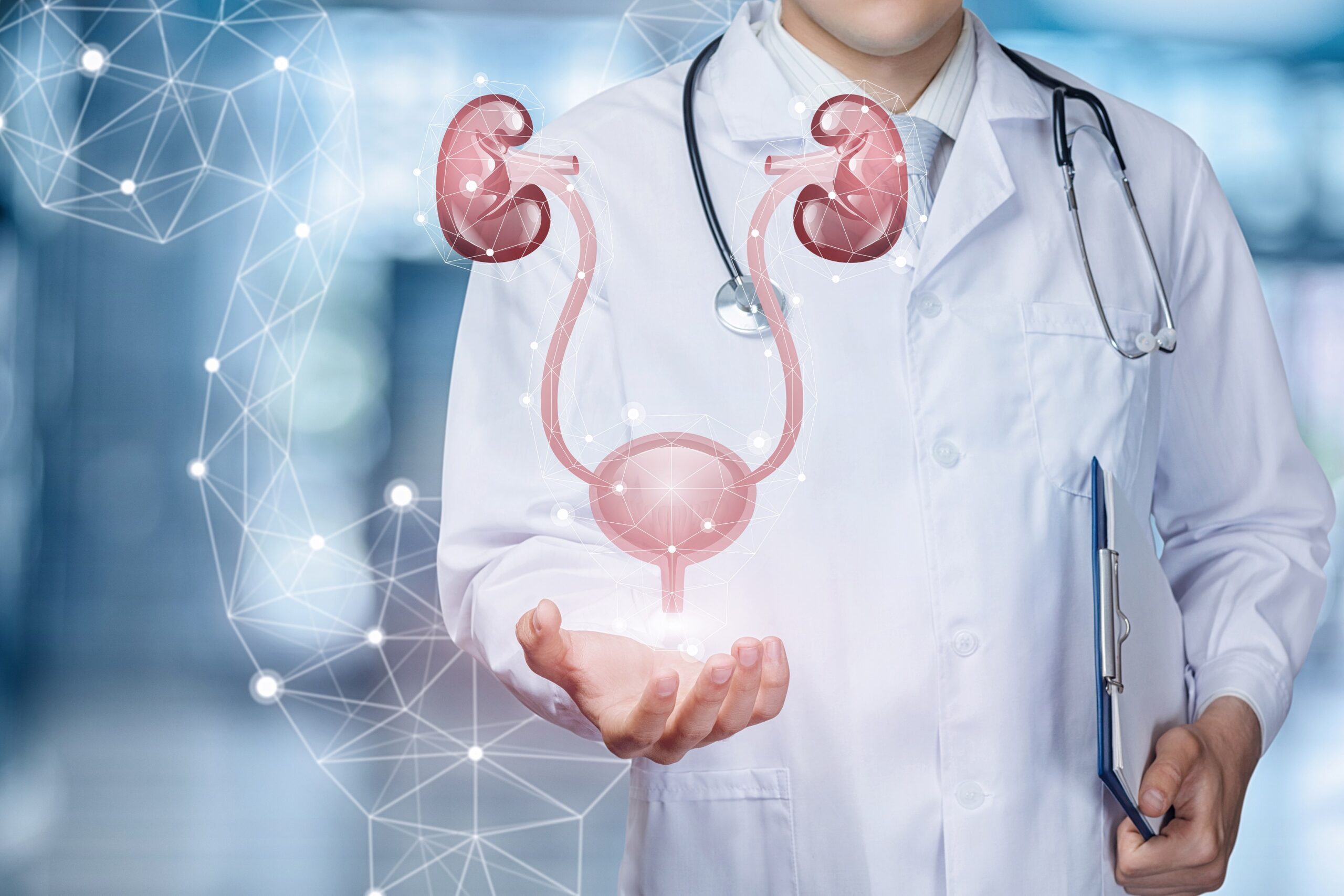Urinary Retention from Prostate Enlargement
The prostate gland is a walnut-shaped organ located just below the bladder and surrounding the urethra in men. People may have a mixed picture between prostate and testicles but they are completely different organs. The function of the testicles is sperm production while the prostate gland produces seminal fluid that protects and nourishes the sperms. The prostate grows in size with age and the level of testosterone and may lead to a problem. Benign Prostatic Hyperplasia (BPH) or prostate enlargement is commonly found in elderly males. It begins at the age around 40 years up until the age of 80 – 90 years, 90% of which has a prostate problem.
Dr. Karan Rimthephathip, our urologist at Bangkok Hospital Hua Hin shares that the symptoms of BPH are caused by two main factors: the prostate obstruction of the urinary tract and the bladder irritation from it. The symptoms may vary and can present with complaints such as weak urine stream, difficulty in starting of urination, interrupted urine stream, dribbling at the end of urination, inability to completely empty the bladder, frequent urination especially at night, inability to hold urine and dysuria, the term indicates painful urination. Some patients may not have any warning symptoms and can suddenly develop the urinary obstruction.
 How to diagnose Benign Prostatic Hyperplasia (BPH)?
When patients develop symptoms and seek medical attention, the doctor will begin by manual examination through the rectum known as Digital Rectal Examination (DRE). This is to check and estimate the prostate gland size, along with any abnormalities suggesting cancer nature. The urine analysis is also required to rule out other diseases such as urinary tract infections.
The further examination is a blood test for PSA (Prostate-Specific Antigen) which is the prostate cancer screening test. This will help to determine the nature of the prostate problems as prostate cancer and BPH share the same symptoms making it difficult to differentiate. This is the reason we suggest that men aged between 50 to 75 years have prostate cancer screening on a yearly basis.
Uroflowmetry and residual urine analysis is often used to assess the urine stream. The stream reflects the ability of bladder to squeeze itself and poor contraction may increase the risk of urinary tract infections. Moreover, it will be used to compare the results before, during, and after the treatment for BPH.
KUB Ultrasound (Kidneys, Ureters and Bladder) The ultrasonic examination is to analyze the urinary tract disorders such as possible masses along with kidney or bladder stones. This examination can also evaluate the size of the prostate as well.
Treatment for BPH
After being screened by DRE and PSA test, patients with enlarged prostate, with negative test do not require any treatments. However, they should be monitored every two years by the same DRE and PSA testing.
In case that patient has symptoms, treatments are required and initiated by behavior modification depending on patient’s conditions. For example, if the patient has to urinate often at night, he should refrain from drinking water, coffee, and tea about 2 hours before going to bed.
For treatments by medications, there are various types of medications doctors use to treat prostate enlargement. The choice of medications and doses vary in individuals depending on how well they respond to the treatment.
Surgical treatments can be divided into 2 cases;
1. If the result of prostate cancer screening shows a risk of prostate cancer, a prostate biopsy is required. The doctor will perform the biopsy using rectal ultrasound probe to locate the prostate, a small biopsy needle will then be inserted into the prostate. The aim for this procedure is to prove the nature of the prostate tissue, not exactly the treatment.
2. Transurethral Resection of the Prostate (TURP) which is the procedure to resect or remove parts of the prostate by inserting the tubal equipment through the urethra under the anesthesia. This procedure will help patients with obstruction of urine flow who do not show improvement from medications or patients with prostate bleeding. The instrument is inserted though the urethra, there are no surgical scars and the patient can leave the hospital within 3 to 4 days.
How to diagnose Benign Prostatic Hyperplasia (BPH)?
When patients develop symptoms and seek medical attention, the doctor will begin by manual examination through the rectum known as Digital Rectal Examination (DRE). This is to check and estimate the prostate gland size, along with any abnormalities suggesting cancer nature. The urine analysis is also required to rule out other diseases such as urinary tract infections.
The further examination is a blood test for PSA (Prostate-Specific Antigen) which is the prostate cancer screening test. This will help to determine the nature of the prostate problems as prostate cancer and BPH share the same symptoms making it difficult to differentiate. This is the reason we suggest that men aged between 50 to 75 years have prostate cancer screening on a yearly basis.
Uroflowmetry and residual urine analysis is often used to assess the urine stream. The stream reflects the ability of bladder to squeeze itself and poor contraction may increase the risk of urinary tract infections. Moreover, it will be used to compare the results before, during, and after the treatment for BPH.
KUB Ultrasound (Kidneys, Ureters and Bladder) The ultrasonic examination is to analyze the urinary tract disorders such as possible masses along with kidney or bladder stones. This examination can also evaluate the size of the prostate as well.
Treatment for BPH
After being screened by DRE and PSA test, patients with enlarged prostate, with negative test do not require any treatments. However, they should be monitored every two years by the same DRE and PSA testing.
In case that patient has symptoms, treatments are required and initiated by behavior modification depending on patient’s conditions. For example, if the patient has to urinate often at night, he should refrain from drinking water, coffee, and tea about 2 hours before going to bed.
For treatments by medications, there are various types of medications doctors use to treat prostate enlargement. The choice of medications and doses vary in individuals depending on how well they respond to the treatment.
Surgical treatments can be divided into 2 cases;
1. If the result of prostate cancer screening shows a risk of prostate cancer, a prostate biopsy is required. The doctor will perform the biopsy using rectal ultrasound probe to locate the prostate, a small biopsy needle will then be inserted into the prostate. The aim for this procedure is to prove the nature of the prostate tissue, not exactly the treatment.
2. Transurethral Resection of the Prostate (TURP) which is the procedure to resect or remove parts of the prostate by inserting the tubal equipment through the urethra under the anesthesia. This procedure will help patients with obstruction of urine flow who do not show improvement from medications or patients with prostate bleeding. The instrument is inserted though the urethra, there are no surgical scars and the patient can leave the hospital within 3 to 4 days.
 Possible Complications If Left Untreated
If there are presented symptoms of BPH and without proper treatments, the following complications may occur,
Possible Complications If Left Untreated
If there are presented symptoms of BPH and without proper treatments, the following complications may occur,
 **************************************************************************
For more information and booking an appointment, please contact :
Tel. 032-616-800 Call Center, Bangkok Hospital Hua Hin
Tel: 032-616-880 (7.00 – 19.00 hrs.) Out-patient Department, ground floor
News & Promotions >> Line : @bangkokhuahin
**************************************************************************
For more information and booking an appointment, please contact :
Tel. 032-616-800 Call Center, Bangkok Hospital Hua Hin
Tel: 032-616-880 (7.00 – 19.00 hrs.) Out-patient Department, ground floor
News & Promotions >> Line : @bangkokhuahin
 How to diagnose Benign Prostatic Hyperplasia (BPH)?
When patients develop symptoms and seek medical attention, the doctor will begin by manual examination through the rectum known as Digital Rectal Examination (DRE). This is to check and estimate the prostate gland size, along with any abnormalities suggesting cancer nature. The urine analysis is also required to rule out other diseases such as urinary tract infections.
The further examination is a blood test for PSA (Prostate-Specific Antigen) which is the prostate cancer screening test. This will help to determine the nature of the prostate problems as prostate cancer and BPH share the same symptoms making it difficult to differentiate. This is the reason we suggest that men aged between 50 to 75 years have prostate cancer screening on a yearly basis.
Uroflowmetry and residual urine analysis is often used to assess the urine stream. The stream reflects the ability of bladder to squeeze itself and poor contraction may increase the risk of urinary tract infections. Moreover, it will be used to compare the results before, during, and after the treatment for BPH.
KUB Ultrasound (Kidneys, Ureters and Bladder) The ultrasonic examination is to analyze the urinary tract disorders such as possible masses along with kidney or bladder stones. This examination can also evaluate the size of the prostate as well.
Treatment for BPH
After being screened by DRE and PSA test, patients with enlarged prostate, with negative test do not require any treatments. However, they should be monitored every two years by the same DRE and PSA testing.
In case that patient has symptoms, treatments are required and initiated by behavior modification depending on patient’s conditions. For example, if the patient has to urinate often at night, he should refrain from drinking water, coffee, and tea about 2 hours before going to bed.
For treatments by medications, there are various types of medications doctors use to treat prostate enlargement. The choice of medications and doses vary in individuals depending on how well they respond to the treatment.
Surgical treatments can be divided into 2 cases;
1. If the result of prostate cancer screening shows a risk of prostate cancer, a prostate biopsy is required. The doctor will perform the biopsy using rectal ultrasound probe to locate the prostate, a small biopsy needle will then be inserted into the prostate. The aim for this procedure is to prove the nature of the prostate tissue, not exactly the treatment.
2. Transurethral Resection of the Prostate (TURP) which is the procedure to resect or remove parts of the prostate by inserting the tubal equipment through the urethra under the anesthesia. This procedure will help patients with obstruction of urine flow who do not show improvement from medications or patients with prostate bleeding. The instrument is inserted though the urethra, there are no surgical scars and the patient can leave the hospital within 3 to 4 days.
How to diagnose Benign Prostatic Hyperplasia (BPH)?
When patients develop symptoms and seek medical attention, the doctor will begin by manual examination through the rectum known as Digital Rectal Examination (DRE). This is to check and estimate the prostate gland size, along with any abnormalities suggesting cancer nature. The urine analysis is also required to rule out other diseases such as urinary tract infections.
The further examination is a blood test for PSA (Prostate-Specific Antigen) which is the prostate cancer screening test. This will help to determine the nature of the prostate problems as prostate cancer and BPH share the same symptoms making it difficult to differentiate. This is the reason we suggest that men aged between 50 to 75 years have prostate cancer screening on a yearly basis.
Uroflowmetry and residual urine analysis is often used to assess the urine stream. The stream reflects the ability of bladder to squeeze itself and poor contraction may increase the risk of urinary tract infections. Moreover, it will be used to compare the results before, during, and after the treatment for BPH.
KUB Ultrasound (Kidneys, Ureters and Bladder) The ultrasonic examination is to analyze the urinary tract disorders such as possible masses along with kidney or bladder stones. This examination can also evaluate the size of the prostate as well.
Treatment for BPH
After being screened by DRE and PSA test, patients with enlarged prostate, with negative test do not require any treatments. However, they should be monitored every two years by the same DRE and PSA testing.
In case that patient has symptoms, treatments are required and initiated by behavior modification depending on patient’s conditions. For example, if the patient has to urinate often at night, he should refrain from drinking water, coffee, and tea about 2 hours before going to bed.
For treatments by medications, there are various types of medications doctors use to treat prostate enlargement. The choice of medications and doses vary in individuals depending on how well they respond to the treatment.
Surgical treatments can be divided into 2 cases;
1. If the result of prostate cancer screening shows a risk of prostate cancer, a prostate biopsy is required. The doctor will perform the biopsy using rectal ultrasound probe to locate the prostate, a small biopsy needle will then be inserted into the prostate. The aim for this procedure is to prove the nature of the prostate tissue, not exactly the treatment.
2. Transurethral Resection of the Prostate (TURP) which is the procedure to resect or remove parts of the prostate by inserting the tubal equipment through the urethra under the anesthesia. This procedure will help patients with obstruction of urine flow who do not show improvement from medications or patients with prostate bleeding. The instrument is inserted though the urethra, there are no surgical scars and the patient can leave the hospital within 3 to 4 days.
 Possible Complications If Left Untreated
If there are presented symptoms of BPH and without proper treatments, the following complications may occur,
Possible Complications If Left Untreated
If there are presented symptoms of BPH and without proper treatments, the following complications may occur,
- The symptoms will become more severe. Patients who have frequent urination at night may suffer from poor quality of sleeping.
- Recurrent urinary tract infections are common in people with BPH because of high amount of residual urine which is a good source of infection.
- Inability to urinate caused by an enlarged prostate. In some patients, kidney failure may develop from the back pressure in the urinary tract system from the blockade.
 **************************************************************************
For more information and booking an appointment, please contact :
Tel. 032-616-800 Call Center, Bangkok Hospital Hua Hin
Tel: 032-616-880 (7.00 – 19.00 hrs.) Out-patient Department, ground floor
News & Promotions >> Line : @bangkokhuahin
**************************************************************************
For more information and booking an appointment, please contact :
Tel. 032-616-800 Call Center, Bangkok Hospital Hua Hin
Tel: 032-616-880 (7.00 – 19.00 hrs.) Out-patient Department, ground floor
News & Promotions >> Line : @bangkokhuahin